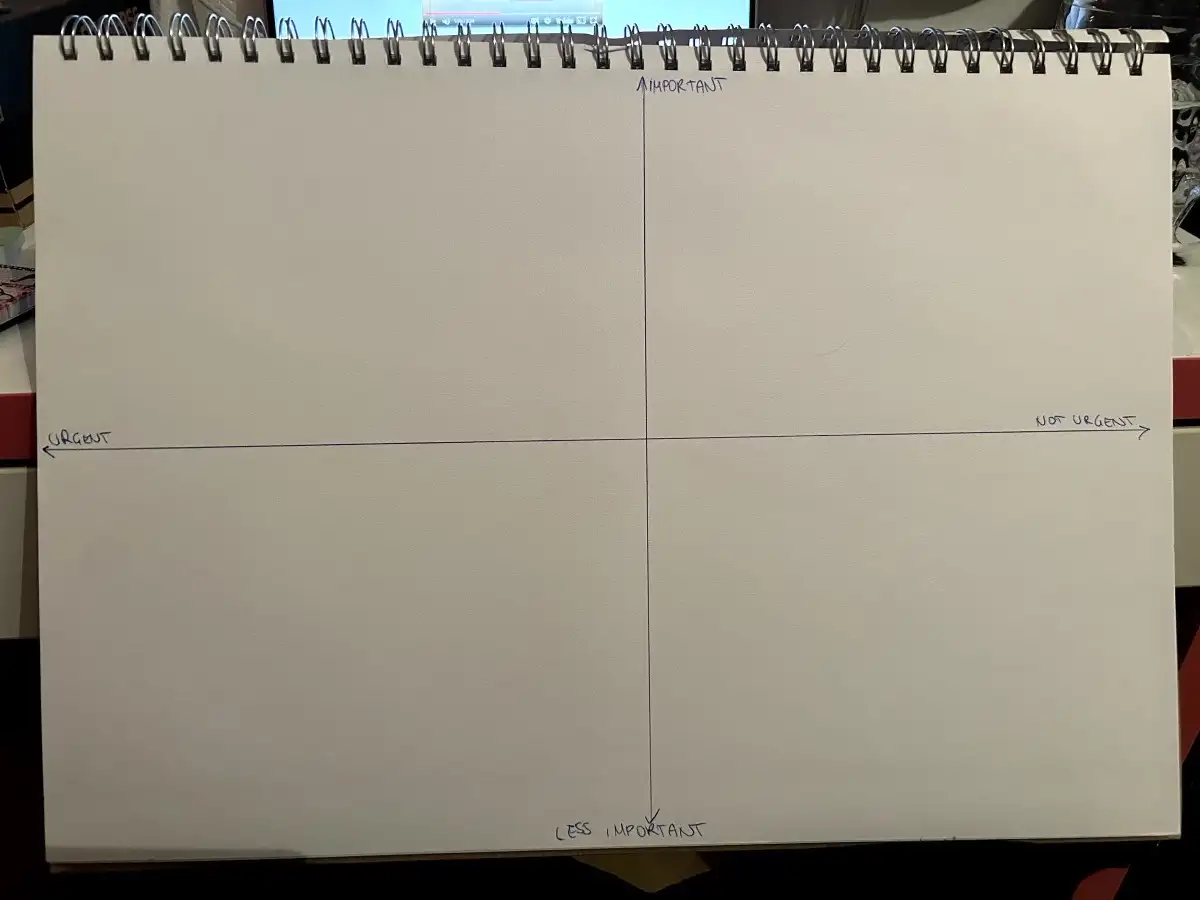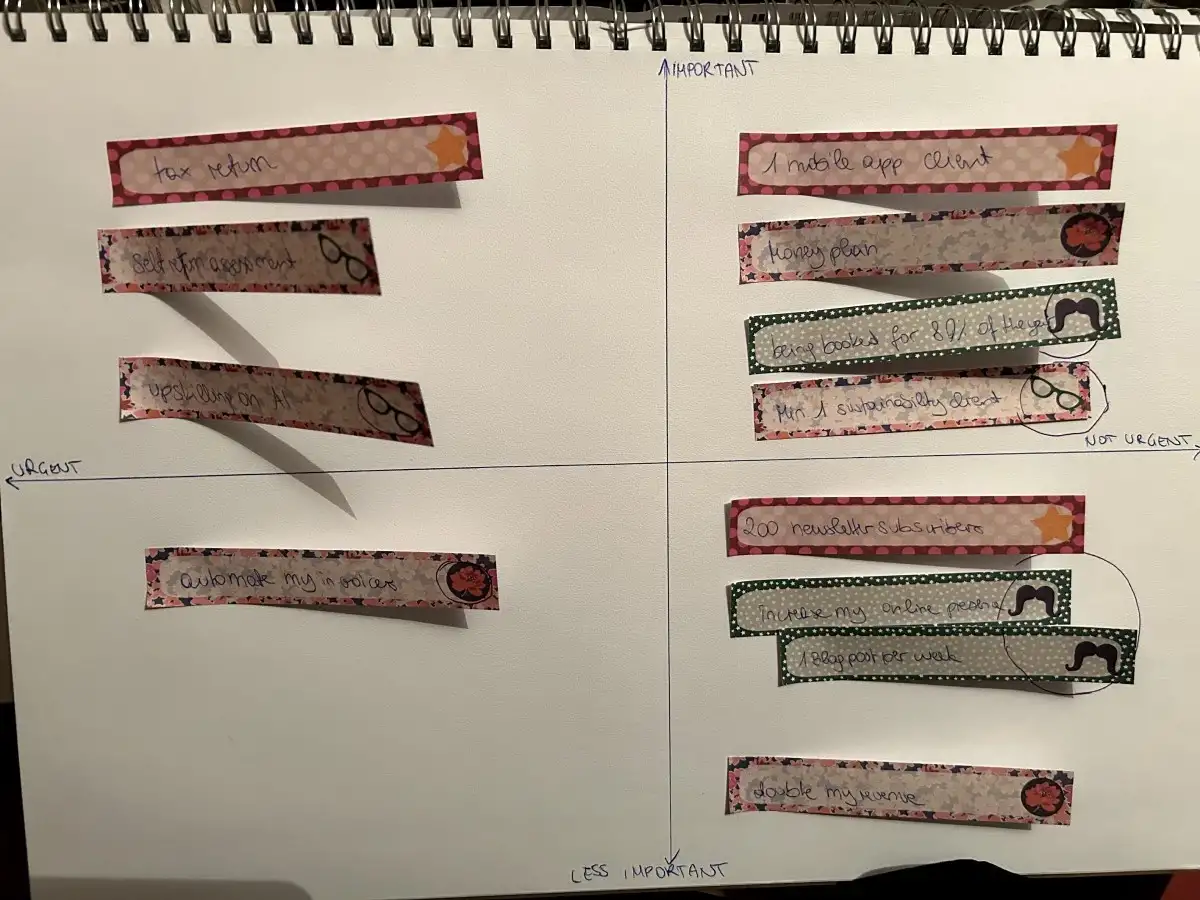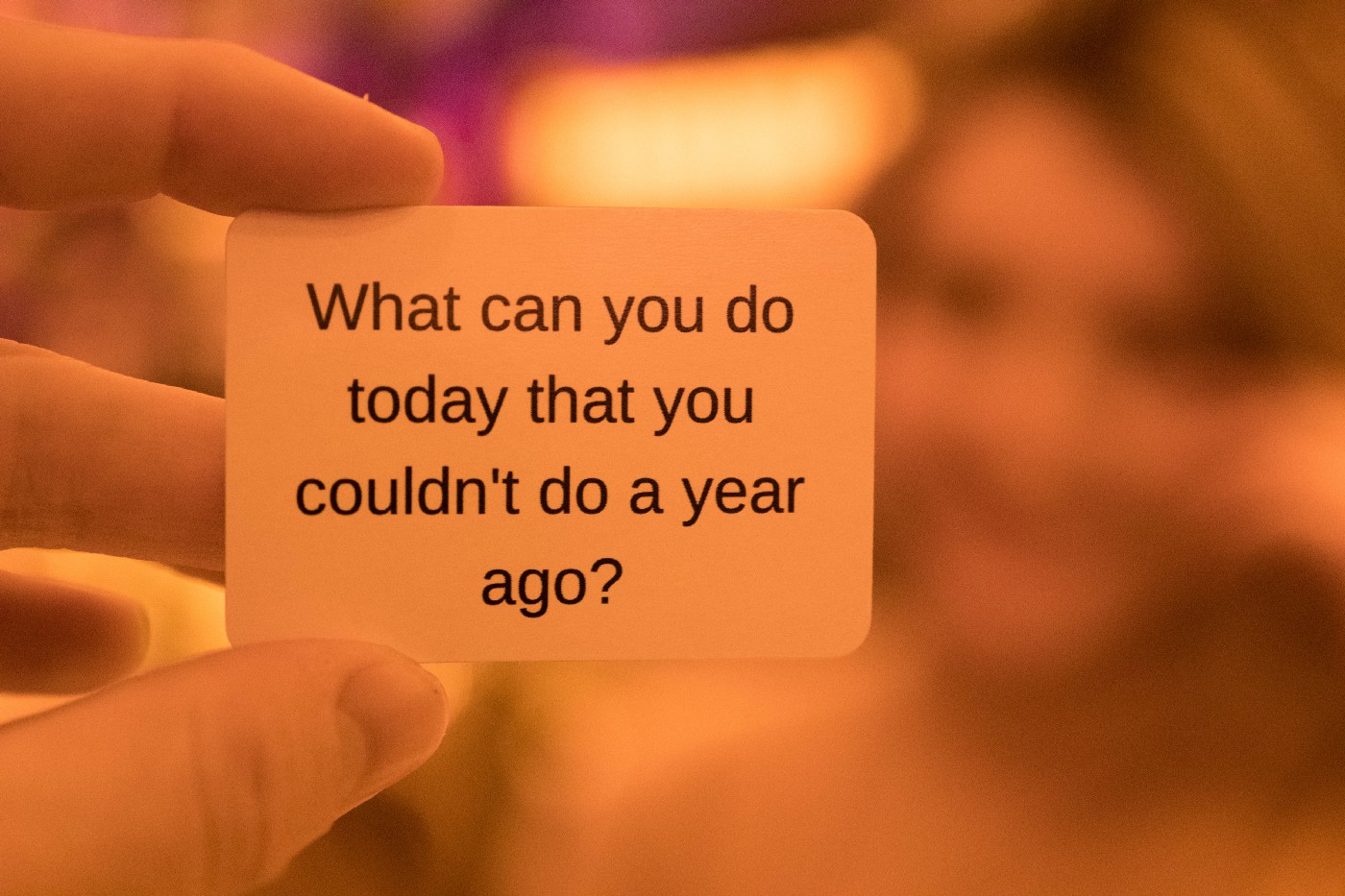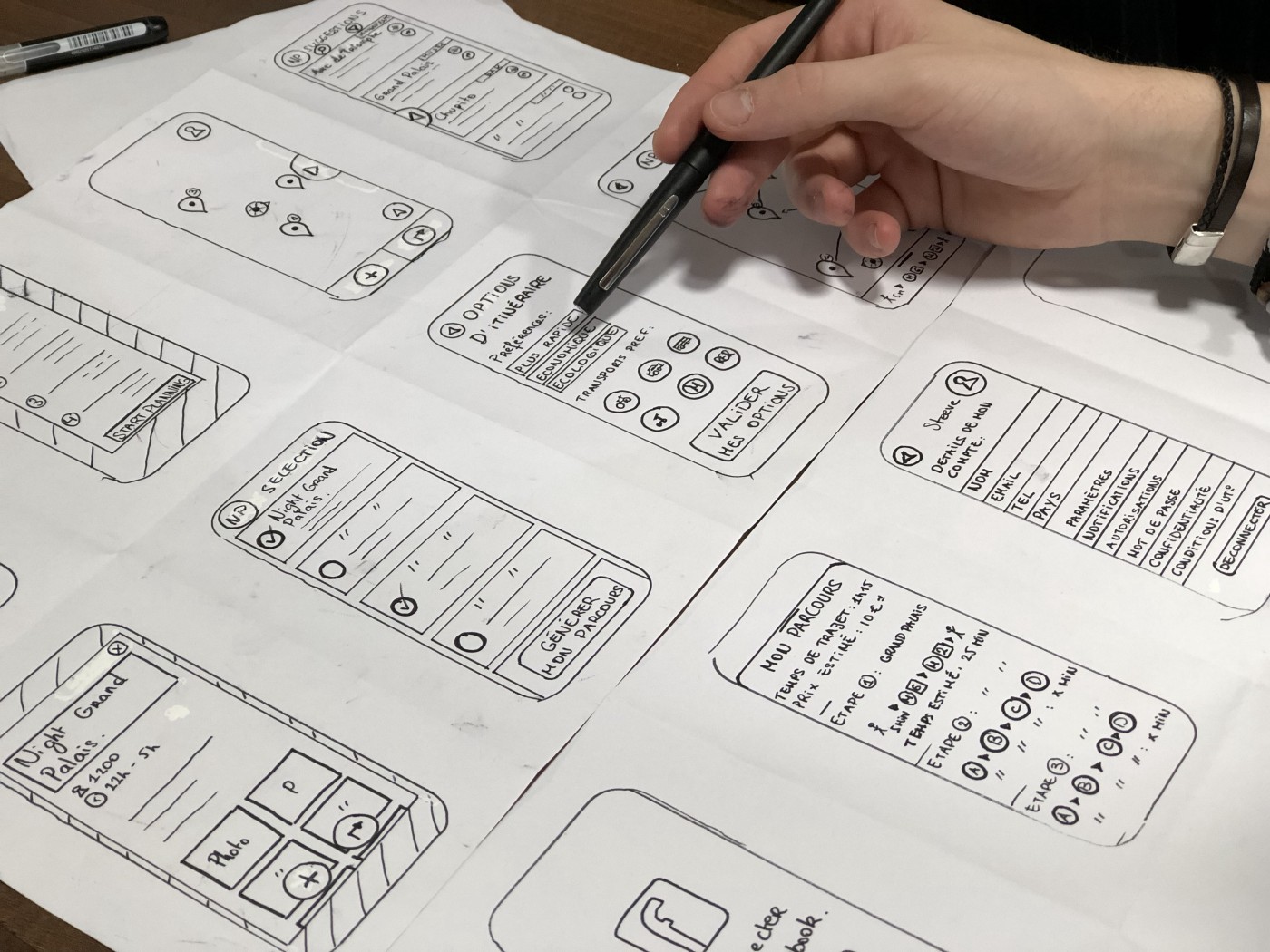Braindump
How I’m trying to actually get shit done this year
Yes, this is the 12,447th article on how to achieve your goals for 2023. But let me tell you something: I’ve been a massive procrastinator and I think I finally found a solution for me.

Photo by Estée Janssens on Unsplash
When it suddenly clicked
I’ve had a little epiphany with my coach. Yes, I’m one of those people now. But as a freelancer, you have to get a coach eventually. You won’t have 360s or a manager to tell you where you should improve, you can only count on your clients’ feedback.
Problem with that is that most of my clients are British. Which means they’re very polite and it’s very difficult to get honest feedback.
Anyway, in my first ever coaching session it turned out that the reason I’m procrastinating is because of fear of success. Such a stupid fear, right? But more about this further down in the article. Let me dive into how to achieve your goals.
So here are the things I’ll be doing differently from now on:
Tell someone about your goal
Telling someone about your goal adds accountability. That person might later ask “How is it going with {enter your goal here}?” and that will keep you on track. Even if they don’t ask you, you might think they ask you. So next time you see them you want to be able to tell them about your progress.
Also, if you hear yourself saying your goals out loud, you make them become more “real”.
What is it that you want to achieve?
Define your goals. And make them SMART. We’ve all learned about that concept at school or at work. If you didn’t, here’s an article by Atlassian that explains it all.
But before you sit down and write your smart goals, make sure you choose your goals for the right reasons.
Define your why
By now everyone must have come across Simon Sinek’s golden circle. Ask yourself why you’re doing what you’re doing. And try to get to the core reason, so ask yourself at least 7 times. Asking why several times is also really useful when it comes to UX Research and user testing. Why does the user want to do this? What’s the problem they’re trying to solve?
I also love using this technique with my clients. Why do we need this feature? Will it be beneficial for the users or is it someone in the company who wants it? Why are we counting these features as MVP and not those? etc etc, you get the gist.
So here’s an example of how I ask myself “Why?”:
I want to write this article. > Why?
Because I’m procrastinating. > Why?
Because I don’t want to do the task I actually should be doing. > Why?
Because I genuinely enjoy writing this article. > Why?
Because I feel it can be useful for other people. > Why?
Because once I realised what’s stopping me from achieving my goals it blew my mind and I don’t want other people to wait this long to achieve their goals. > Why?
Because I can’t stand watching people waste their lives by doing things they don’t enjoy. > Why?
Because I wish I would’ve started the life I’m living now way earlier.
So, turns out I’m writing this article because I regret not going freelance and becoming a digital nomad earlier.
Ask for help
This can be a friend, a colleague or if you’re self-employed, it can be a coach. I’ve only recently started having coaching sessions and I can already tell it’s a game changer!
As I mentioned before, during one coaching session it came to the surface that the reason I’m procrastinating is because I have fear of success. Can you imagine this was my first ever coaching session? Turns out it’s more common than you think. And the reason I have fear of success is because my subconscious mind thinks that successful people are bad people. Think of Jeff Bezos: He has a multi million dollar company but his employers work ridiculous hours for little to no money.
The reason I have fear of success is because my subconscious mind thinks that successful people are bad people.
Of course, not all successful people create this image. Look at Patagonia founder Yvon Chouinard who decided that all the profits will go to protect the environment.
Find things that contradict your limiting beliefs. Once I realised it’s in my power if I want to be a ‘good’ or ‘evil’ successful person, I stopped procrastinating as much. (To be fair.. me writing this article is probably still me procrastinating on something else.. but it’s a progress and I’m not perfect.)
Also, who is saying that I’m going to be successful? But by not trying to achieve my goals, I already kill the opportunity to be successful at the source.
Either way, since this epiphany:
✅ I started to create more content.
✅ I’ve published my first article on medium.
✅ I’ve been more active on my public facing instagram account for freelancers
✅ ✅ ✅ I’ve ticked a lot of things off my to do list that have been sitting there forever and
✅ I’ve decluttered all the tasks that aren’t important.
How to tackle your goals
Setting goals can be overwhelming. Once you have your goals they can lead to a massive to do list. And before starting on that journey, it might feel easier to not start at all. But let me tell show you this inspiring quote from Charlie Mackesy:
One step .. pic.twitter.com/FIk4RxLCwv
— charlie mackesy (@charliemackesy) November 7, 2022
Just take one step at a time.
So here’s the steps you can take:
1. Write your goals down
You can do this with post its, on Miro or an Excel spreadsheet; whatever you prefer working with. Brainstorm all the things that you want to achieve.

Yes, those are very illegible post its that I found at my parents’ house over Christmas. No, I don’t know who invents something like that.
2. Sort your goals
Draw a horizontal and a vertical line to create a diagram for all your tasks and goals. Range things from important to unimportant and urgent to not urgent. That’s the Eisenhower Matrix.

Apologies for the high quality photo
Now add your goals and put them in order for "important" and "unimportant" and "urgent" and "not urgent".

Yes, they’re not all smart goals. But for ease of demonstration, here’s roughly the goals I have for my business this year.
3. Prioritise your goals
Once you’ve done that, the satisfying part starts:
1. Scrap everything on the ‘unimportant’ and ‘not urgent’ section.
2. Delegate the things that are less important but urgent. I like to outsource my company finances for example.
3. Schedule the things that are important but not urgent.
4. Concentrate on the important and urgent tasks.
In general, I really like that concept. However, I think there’s one important part missing: The benefit of achieving each goal.
What’s the benefit?
There’s something I realised when I set my goals this year and it was this: Just because something is not important or not urgent doesn’t mean that it shouldn’t get done. For example, is the goal of me writing this blog post important or urgent? No. So according to the Eisenhower Matrix, I should scrap this goal from the list.
But is there going to be a benefit? Hopefully there is for you who is reading this. When I answer the question for myself: Yes, because it is going to help me build an online presence. Which will help me with the goal of gaining my audience’s trust. Which again will help me to sell my services online and means I need to spend less time on finding clients. So there’s a benefit to it.

Last one of these high quality pictures, I promise.
So instead of just scrapping the things in the 4th quadrant, I’ll keep the goals that I deem beneficial. I go through the matrix and circle all the things that I feel are beneficial to achieve.
4. Create your to do list
Now we can get started. If your goals aren’t smart already, make them smart. And break them down into smaller chunks. And prioritise those again.
I once heard a podcast where someone said that in the past, the word “priorities” didn’t exist. There was only the word “priority”, no plural. It’s only since recently that we’ve chosen to have more than one priority, which kind of defeats the purpose. If everything is a priority, nothing is a priority. If you’ve listened to this podcast or know who said it, please email me, I’d like to add the source to this article.
So start with your priority. If it feels too big of a task, break it down.
5. Pick a small thing each day
Just think about one thing you can do today. It doesn’t have to be a big thing as ‘Create a website’. You can divide it into smaller chunks:
• Choose a name for your website
• Buy the domain
• Look into website builders (Squarespace, Wix, Webflow… there are so many cheap and even free options)
• Pick a platform to build your website in etc
Or even better, take an MVP approach. If you don’t know what an MVP is, it stands for ‘Minimum viable product’. So instead of creating a full website, define what is actually needed. What is the problem you’re trying to solve? Let’s say your problem is that you don’t have a digital portfolio. So you can’t just send people a link to your work.
Maybe instead of creating a whole website for your portfolio, start with something like Behance or Notion. They have a template for almost anything and guess what? They have a template for portfolios.
Whatever it is that you’re trying to achieve: Give yourself 5 minutes each day to tackle the task. And trust me, you will continue voluntarily for more than those 5 minutes to get things done. Most of the time it’s just about getting started and getting into the right habits.
6. Eat the frog
There might be a task that feels more daunting than others. One that makes you want to give up or will trigger your procrastination cycle. Do that task first. Eat. The. Frog.
One more thing
This one hit me hard the first time I heard it.
If you don’t do something you said you’d do, you’re betraying yourself.
Let me say it again for the people in the back:
If you don’t do something you said you’d do, you’re betraying yourself!
Stop standing in your own way
Every time I tried to do something from my to do list I’d end up procrastinating. Or I decided to do something else instead. Something that needed to be done but doesn’t have as much of a priority or an impact.
I think everyone has been in the situation where they have to do something but then end up cleaning the flat. Because it feels productive. Instead of doing the task at hand, you decided to do something else instead.
That’s not helpful. Yes, something gets done, but not the thing that will benefit you the most.
By choosing to do something that isn’t urgent you’re just standing in your own way of achieving your goals. Remind yourself why you’ve set that goal and what the benefit will be. Yes, taking out garbage and hovering the floor is beneficial too, but doing the tasks for achieving your goals are usually more beneficial for you in the long run.
One last thing on accountability
My overall goal is to build trust with my audience. And as a subtask for that I’ve been creating a small piece of content every day. This article is my content for today. It was quite out of my comfort zone at the beginning but the more I’ve done it, the less scared and worried I became.
I’m also planning to start my newsletter soon. So far I have about 20 people on the list, so there’s not that much to lose, only to gain. If you want to be the first to read it, you can sign up here.
See what I did there?
I told someone (if you’re still reading this) what I’m about to do. You might not hold me accountable personally, but I feel more pressure to actually get it out there because I’ve told someone about it. And I’ve told myself I’ll do it. And if I don’t do it, it means I’m letting myself down.
Alright, this is it. This is all of my rambles. Hopefully you found this useful and can implement some of those tips to achieve your goals. I believe in you!



